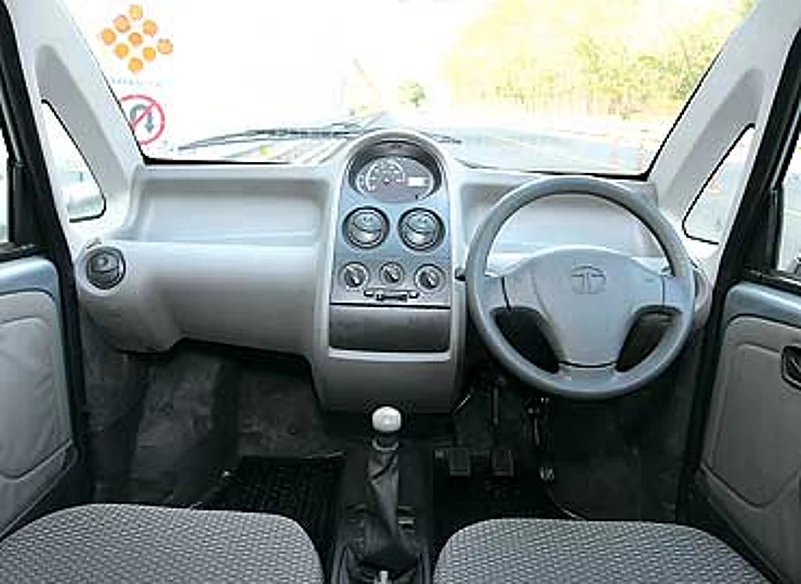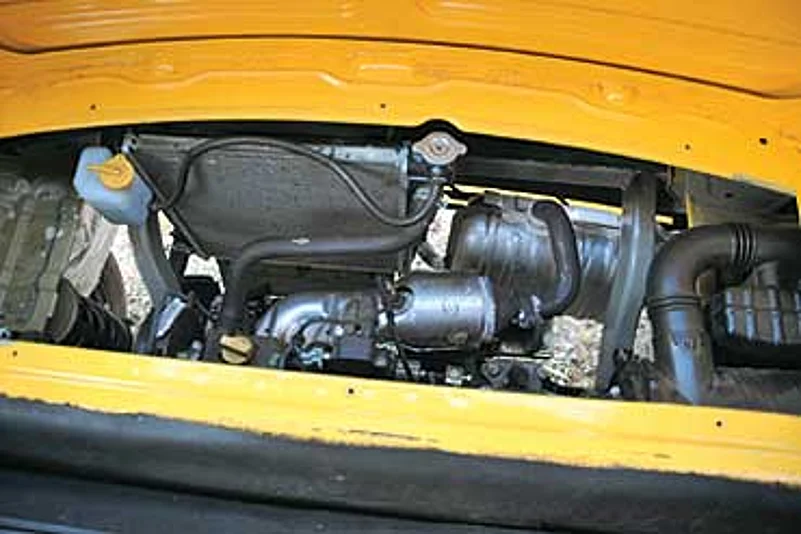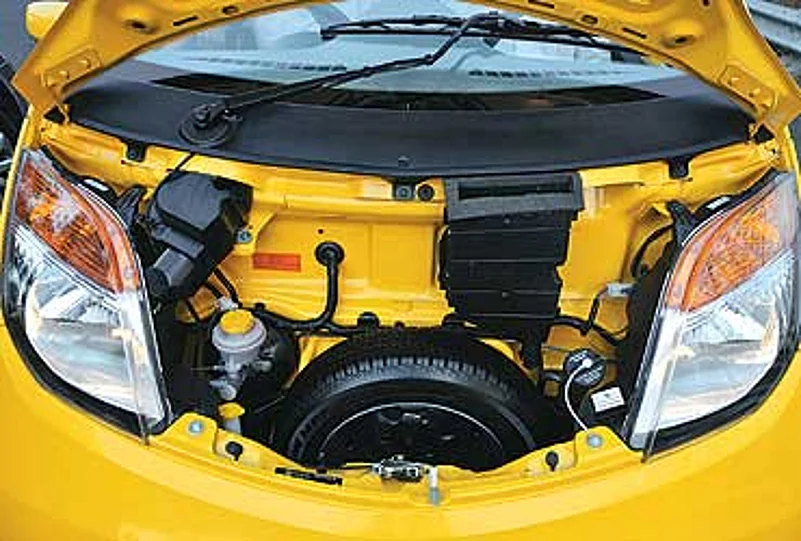
Hormazd Sorabjee
Editor, Autocar India
Doubts about the Nano's celebrity status were immediately dispelled on a drive through Pune streets days before the launch. The car was mobbed wherever we parked. People wanted to touch it, jump into it, press their faces on the glass and even pose for pictures next to it. In Chakan, we halted near a bus stop and commuters almost forgot their ride home. The only thing that could have grabbed more attention was perhaps Aishwarya Rai driving topless in a red Ferrari.
Much of the Nano's aura centred on what Tata Motors could deliver for Rs 1 lakh. After driving it in Pune city, on the highway and rural backroads, I can endorse that it's turned out to be a proper car and not an excuse for one.

The centred instrument cluster
Central to Nano's charm is its cute and cherubic styling. That's because design is one area where Tata hasn't taken the cheaper way out. Using simple and flat body panels or flat-plane glass would have saved costs but could have resulted in a shape that had the appeal of a breadbox. The Renault Logan is a case in point. Moving the engine to the rear has freed up passenger space within a finite footprint and has allowed Tata to achieve conflicting goals of compact dimensions and generous passenger space.
For a car with a small footprint, the interior space is unbelievable. The doors open wide and the high seats allow you to slide in with ease. Getting in and out of the Nano is easier than in an S-Class and that's no exaggeration. The seats themselves are a bit hard and flat with no bolstering or lateral support—a bit like a bus. But high-seating makes the Nano remarkably comfortable and the headroom is astonishing. The interiors are well designed but basic. The beautifully sculpted dashboard has large cradles to hold odds and ends, which compensates for the absence of a glove box. The quality of plastics, buttons and vents are a bit flimsy, but at this price it's quite acceptable.

The engine
Air-conditioning is standard in the CX and LX versions and provides decent cooling for the front passengers but the small 60 cc rotary compressor struggles to reach the rear passengers when it's really hot. Besides, the engine heat that seeps out from behind the rear seats also makes cooling a challenge. I wish there was an opening tailgate—you have to flip the rear seat forward and wiggle your bags through the rear doors to access the small luggage area above the engine.
The 624 cc, twin-cylinder engine is a bit noisy and sounds like a cross between an auto-rickshaw and a bike. There's enough pep, especially in first and second gear, and keeping up with and even dodging city traffic is easy. It never feels like hard work, except on steep inclines. The shift action of the four-speed gearbox is crisp, in fact better than the Indica. Then there's the astonishing turning circle, possibly the tightest on any car. The ability to hang a U-turn on any street, the seating and great all-round visibility makes the Nano at home in a congested, low-speed environment.
On the open road, it's another matter. It runs out of puff quite quickly. Progress after 70 kmph is lethargic and top speed is limited to 105 kmph. This certainly isn't a highway car but that's not going to stop people from using it as one. That's why Tata engineers have worked hard to ensure it's fairly stable with a full load at max speed. The Nano with its tall stance and small wheels is quite top-heavy and rolls around a bit through corners but there's never a fear of keeling over and the brakes are good enough to stop such a light car.

The bonnet with a spare tyre
For a car that weighs a mere 600 kg, the Nano feels incredibly robust. The suspension copes with most road surfaces and the Nano's massive ground clearance can shame some off-roaders. The ride, as expected in a car with such small dimensions, does get a bit choppy on uneven surfaces but it's not unbearably bouncy. At Rs 1.23 lakh (ex-showroom Delhi), it's a triumph of pocket science over rocket science.

Sirish Chandran
Editor, Overdrive
You get into a car costing a lakh of rupees with little expectations. Things are bound to break, you tell yourself, and you take off gently. Being Indian I even forced myself into a charitable frame of mind, ready to overlook faults. After all, as a teaser from Tata Motors once said, "Ek lakh mein aur kya milega? (What more can you get for one lakh?)" Well, after driving the car, I can confidently say you can expect a hell of a lot!
It starts with the way the car looks. It's a happy little thing—simple, yet eye-catching. It's a shape that'll go down as an instant design classic, much like the VW Beetle and the original Fiat 500. And it cloaks an interior package that will truly shock you. It's astonishingly spacious. Tata Motors claims it has 21 per cent more interior room than a Maruti 800, but it actually feels even more so, particularly since the seats are so high and headroom is so massive.
Then, the quality of the interiors isn't horrid. It's cheap, of course, but does not feel nasty—because there are only a few modules, fit and finish isn't an issue. At 80 litres, there's not much of a boot but flip the seats and you get 500 litres—enough for the week's groceries.
Under the boot lies the engine, a tiny little twin-cylinder 624 cc, four-valve, all-aluminum unit that makes a measly 35 PS of power—but it has only 600 kg to lug around. Initial gearing is short, so it can pick speed quickly in the first two gears; 60 kmph comes up in 9.8 seconds, which is respectable, and she can keep pace with traffic. Slot it into fourth and it gets laboured—this is a tall gear meant to extract the best fuel efficiency and it means getting to 100 kmph needs a yawning 35.1 seconds.
But what fuel efficiency! The ARAI claimed figure is 23.6 kmpl and that's the best for any Indian car. It also meets current BS III emission norms which is 12 per cent lower than any motorbike in the country; a fitting rebuttal to all those claiming an environmental calamity.
The Nano has a limited top speed of 105 kmph, which all but rules out any highway duties. But the city is where it's most comfortable and an absolute hoot to drive. The steering is quick, direct and power-assisted because there's hardly any weight up front. Though it rides on tiny 12-inch wheels, the grip is decent, allowing it to be thrown around with surprising verve. It's safe and never feels like it'll land on its roof.
The four-speed manual gearbox shifts better than the Indica—and makes easy work of keeping the engine on the boil and it can dive between buses and nudge to the front of the queue. The 8-metre turning circle means it can whack U-turns in impossibly sized gaps. It's so quick through the city that Tata engineers accompanying me couldn't keep up in their Indica. Remember that Pac-Man arcade game where you had to eat the dots while being chased by ghosts through a maze? You've now got the picture of a Nano in the city.
And she is as safe (or unsafe) as most other cars in India. In a nutshell, the Nano doesn't feel like half a car. Ignore cheap rubber parts, a coat or two less paint, only one wing mirror and there are no visual signs of cost-cutting. Ultimately, that's what will make the Nano India's class-buster. If reliability issues are sorted out, I can guarantee Tata Motors has a huge success on its hands.


























